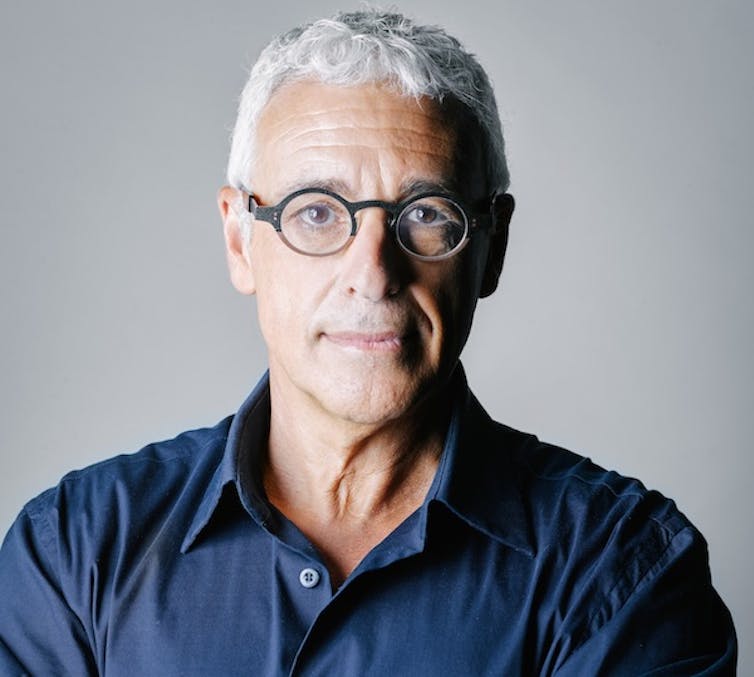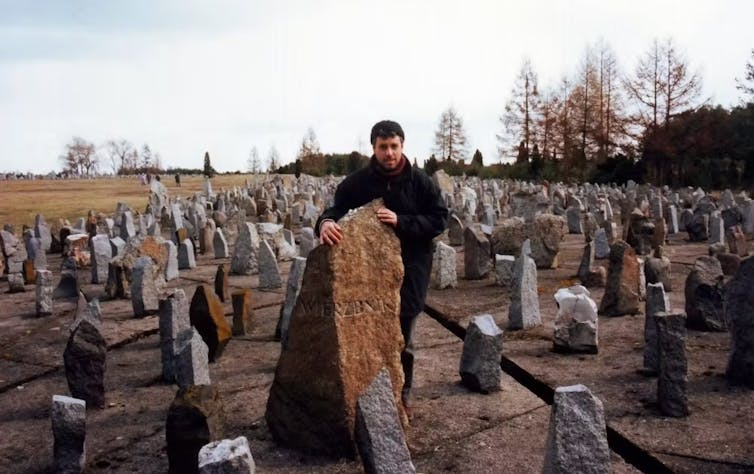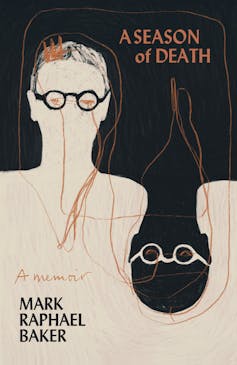Mark Raphael Baker at Treblinka death camp on a research trip. Provided by Raimond Gaita
Mark Raphael Baker began writing his final book, A Season of Death, from his hospital bed, in the wake of his terminal pancreatic cancer diagnosis. His second wife, Michelle, would later observe: “More than a comfort or distraction, in him it was a need.” The renowned Jewish Australian author and academic died a year later, after 13 months of illness, aged 64.
In 2022, after nearly four months of misdiagnoses and inaction from doctors – despite persistent complaints of unbearable abdominal pain – an MRI had finally revealed the grave news. Cancer would claim his life, as it had his first wife Kerryn in 2016 (aged 55), and his brother Johnny in 2017 (aged 62).
He wrote:
I kept thinking, this can’t be happening. I was invulnerable. The odds of another person in one family being hit by terminal cancer seemed impossible.
How does one write the essence of a life once it has come to an end? Baker was no stranger to this question.
Review: A Season of Death – Mark Raphael Baker (Melbourne University Press)
His first book, The Fiftieth Gate: a journey through memory (1997), is an exploration of his parents’ Holocaust survival, told through the eyes of a son grappling with his connection to their trauma. When it was reissued for its 20-year anniversary in 2017, it had sold over 70,000 copies. His second book, Thirty Days: A Journey to the End of Love (2017), was written after his first wife, Kerryn, lost her ten-month battle with stomach cancer.
Death shaded much of Baker’s life. Writing was his salve, a window to understanding and hope.
Baker was director of the Australian Centre for Jewish Civilisation and associate professor of Holocaust and Genocide Studies at Monash University. Religion, which was central to his family and intellectual life, is woven throughout the memoir.
 Death shaded much of Mark Raphael Baker’s life. Writing was his salve. Paul Philipson/Text
Death shaded much of Mark Raphael Baker’s life. Writing was his salve. Paul Philipson/Text
Liminal grief
A Season of Death is short, at 253 pages. It is structured in five parts: Regeneration, Remarriage, Re-Creation, Retribution and Revelation. The repeated prefix “re” (meaning again, or back) speaks to the cyclical nature of life as Baker lived it.
The book begins with Kerryn’s cancer diagnosis, seven years prior to his own. Baker writes, “That experience followed me; every breath I took felt like Kerryn’s last breath.” He continues:
Death and life became inextricably bound; I was unsure which world I belonged to, and in my dreams at night I danced with her spirit, sang the songs of our courtship, reanimated her in my mind and eventually rushed to write a version of our life story, which I completed in thirty days.
Baker writes beautifully and eloquently about the liminality of existing in grief after such a profound death. Less than two years after Kerryn’s passing, Baker’s brother, Johnny, also died of cancer. This death was particularly difficult for Baker’s parents, who both survived the Holocaust.
For many survivors of genocide – who’ve lost their family, their sense of place, everything – children become the centre of their universe. This was certainly the case for Baker’s parents:
What to say to these people whose entire existence revolved vicariously around the successes of their two sons? When my mother was asked about her idea of revenge for what she had suffered, her answer came back without hesitation, “You, my children, are my revenge.”
‘Something was seriously wrong’
The book is written in a fragmented style, traversing past and present, shimmering between early childhood memories and life as an adult.
We are with Baker through his courting of Michelle Lesh, who he had first known as the stepdaughter of his close friend, Raimond Gaita. Their relationship transformed and deepened through their shared intellectual and political interests, particularly concerning Israel-Palestine, and centred around travel and their respective careers. They were married in 2018 and in 2021 welcomed a daughter, Melila.
We are with him as he reflects on his parents’ survival of Holocaust Europe and the trauma they experienced. (Baker’s father died in 2020, three years after his brother Johnny. Baker’s mother, Genia, was 88 when he died in 2023.)
And we are with him in the doctor’s office as his worst fear becomes reality.
The best word for my reaction was one of bewilderment. Something was seriously wrong. We’d talked about pancreatitis but that was different from pancreatic cancer. I was numb. It didn’t feel possible, but I immediately pictured my death. The only question in my mind was if I would last as long as Kerryn and Johnny.
For anyone touched by cancer, this feeling of bewilderment is familiar. Few diseases have a more profound physical and psychological impact. Baker observes, often with searing clarity, his own corporeal degeneration and his thoughts as he confronts his own mortality.
“While no number of deaths could make me indifferent to what awaits me, watching a sequence of deaths in the family has made me more prepared,” he writes.
I feel as though I have been trained or mentored in the art of dying. My fear is less the prospect of my ultimate demise than the pain I will endure reaching the end.
What is surprising is Baker’s persistent humour and palpable energy, despite the pain and despite the closeness of his ultimate demise.
An act of love
A Season of Death is not an easy read. It is an intimate, at times harrowing portrait of grief and of death. What Baker has written is a final observation of his life, offering a rare perspective on death – and life as it comes to an end.
To persevere with a writing project in the midst of such bodily trauma, to write through and towards death for his children, for his family and descendants, is an incredibly courageous feat.
“Over the course of his illness Mark wrote almost every day, despite the ravages and debilitating side effects of his treatments, which often left him weary in body and mind,” write Lesh and his friend Raimond Gaita, in the book’s postscript.
Baker passed away before the book was published, and Lesh and Gaita brought it to publication in his absence. In their postscript, they observe:
Writing the memoir was an act of love that took possession of him. It gave him comfort and energy. He sacrificed sleep, physical and mental rest, and refrained from engaging with people and aspects of the world to which he had previously given so much of himself.
What lingers with the reader is a sense of the fragility and miracle of being alive for the very short time we each have. We are all going to die, and whether or not this fact is a preoccupation, it is moving to witness, through writing, an at once introspective and philosophical mind work through his imminent death.
There is no linear story, or discrete chapters. There is no Before or After. There is only the projection of what was and what might have been: memory – fickle, pliant, circular, fragmentary.
Tess Scholfield-Peters, Casual Academic, Faculty of Arts and Social Sciences, University of Technology Sydney
This article is republished from The Conversation under a Creative Commons license. Read the original article.



